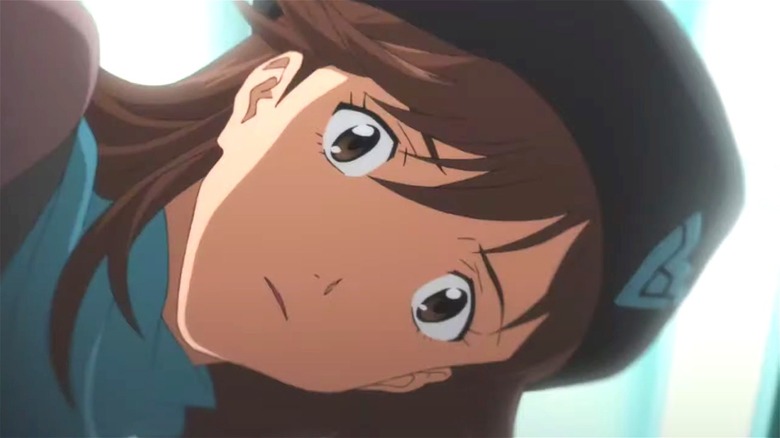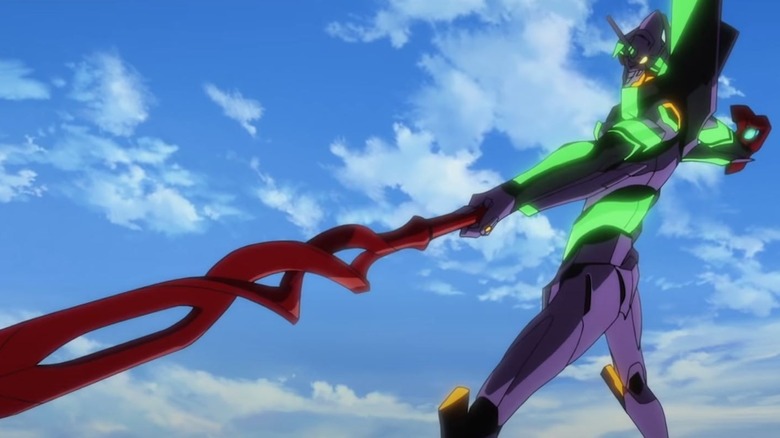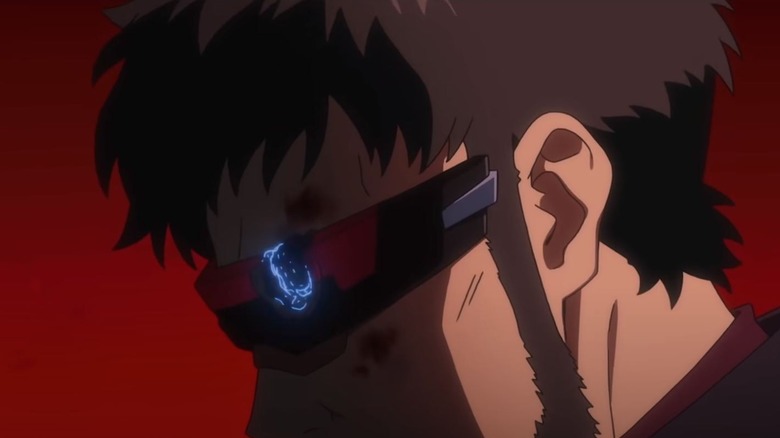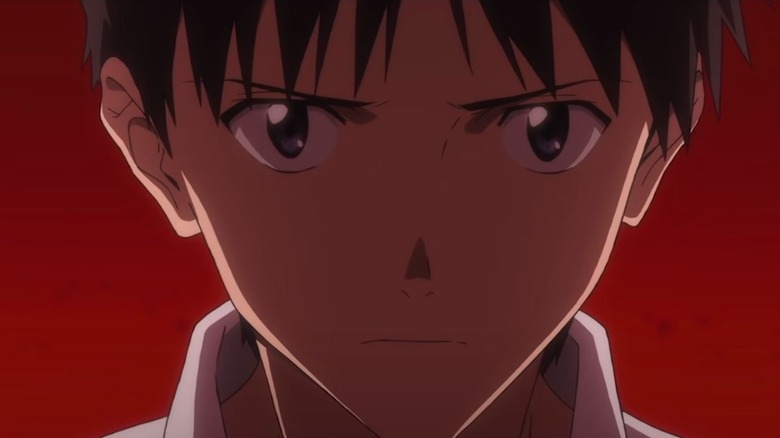The Ending Of Evangelion 3.0+1.0 Thrice Upon A Time Explained
"Neon Genesis Evangelion" is famous for appearing to be a cool post-apocalyptic show about kids who pilot massive robots that battle giant mystery beasts in order to stop disasters. It's even more famous for the fact that under this shiny veneer, the show is actually something much, much stranger.
As the series progresses, the dangerous Angels turn into far more abstract figures, and the big robot fights give way to a whole bunch of complex psychological stuff. At the end of the original "Neon Genesis Evangelion," it turns out that the show was essentially about protagonist Shinji's (Megumi Ogata) — or, rather, creator Hideaki Anno's — struggles with depression, as the final episodes transcend their genre, premise, and setting by twisting into an odd, visually wild meditation on hopelessness (via Polygon).
The quality of "Evangelion's" premise and storytelling would arguably have been enough to propel the show to anime legend status without any extra elements. However, the show's penchant for religious imagery, body horror, and psychological tones truly cemented its place as a stone cold high-concept classic. What's more, the story has since been told in differing ways, which just adds to the confusion.
The latest version of the "Evangelion" story is "Rebuild of Evangelion," a tetralogy of movies that revisit the plot in a somewhat more easily digestible, but also quite different form. With "Evangelion 3.0+1.0: Thrice Upon A Time," the tale finally comes to a conclusion — and boy, what a conclusion it is. Let's take a moment to revisit the ending of "Evangelion: 3.0+1.0 Thrice Upon a Time."
Rebuilds, hedgehogs, and mental anguish
The "End of Evangelion" movie developed another possible ending to the story. It revisits the original's plot point of Human Instrumentality, an event in which humanity and its originator, Lilith, fuse into one. However, while the original version ended with Shinji accepting this, "The End of Evangelion" version of the character bluntly rejects the event, stranding him with the disgusted Asuka (Yūko Miyamura) on a barren, destroyed Earth. "Evangelion 3.0+1.0: Thrice Upon a Time" takes things to a yet another direction, and gets you there with what might just be the wildest "Evangelion" rollercoaster ride yet.
By the time the final "Rebuild of Evangelion" movie rolls along, its predecessors have continued to tinker with the franchise's mythology, while changing multiple events and details from the previous tellings. A particular standout is Asuka's wild arc, full of Angel-hiding eyepatches and clone reveals.
Like "Evangelion: 3.0 You Can (Not) Redo)," "Evangelion 3.0+1.0: Thrice Upon a Time" takes place 14 years after the Third Impact, which Shinji inadvertently caused in "Evangelion: 2.0 You Can (Not) Advance." Humanity is slowly getting back in business, old friends and acquaintances are getting older, WILLE and NERV are both driving their own agendas ... and a still-teenage, still-insecure Shinji is on his way to a final confrontation. In true "Evangelion" fashion, it all comes across as one of the franchise's many metaphors about the world moving on, while Shinji is stuck on repeat.
Gendo gets his day in the limelight
Regardless of whether you place Gendo Ikari (Fumihiko Tachiki) on your list of scariest anime villains, he's most certainly one of the worst fathers in fiction. The bearded NERV leader has caused his son no end of torment and abandonment issues throughout the franchise — but this time, things play out a little differently. The inevitable confrontation between the father and the son takes place on a peculiar divine plane called Anti-Universe, which humans can't properly perceive, and which contains things like a black "imaginary" version of the Second Angel, Lilith. As such, things get supremely weird.
A visually wild, reference-filled battle between Shinji and Gendo leads nowhere, and it transpires that Gendo's ruthless need to cause an event called the Additional Impact is actually a desperate attempt to recreate reality. The father and son start talking, and a surprisingly raw and intimate look inside Gendo's history and motivations reveals his true nature. Turns out, Gendo used to be a shutoff like his son, and his villainy is actually the product of the pain and trauma he suffered when Yui (Megumi Hayashibara), the only person who could help him out of his shell, died. The "like father, like son" theme goes as far as giving young Gendo the same kind of Walkman Shinji has used to shut himself away throughout the franchise.
As the father and son finally open up, and Gendo's plan to meld humanity's minds into a singularity so he can be with Yui once more comes clear — and through the magic of conversation, both Gendo and Shinji attain closure and a modicum of peace. It's a heartwarming moment, and fans only needed to wait 26 years to see it.
Rebuild without Evangelion
The "Neon Genesis Evangelion" franchise has been around since 1995, and throughout that time, it has essentially told the same story over and over again, with varying differences. From Kaworu's (Akira Ishida) insistence that he's met Shinji many times before to Gendo's reality-bending endgame, several things in the "Rebuild of Evangelion" movies insinuate that the entire franchise may be a time loop that's periodically reset — possibly by a particularly bad Impact — and Shinji is essentially stuck in a nasty "Groundhog Day" scenario without knowing it. There's obviously more to it than that, but the fact that Hideaki Anno's statement about the films (via Anime News Network) called the "Evangelion" series "a story that repeats" does seem to support this.
Of course, if there was a time loop, the end of "Evangelion 3.0+1.0 Thrice Upon a Time" makes sure that it's well and truly broken, When the humbled Gendo steps away from his plans, Shinji is left with the tools to remake the world. In the original show, a similar scenario ends in an ambiguously hopeful way, when Shinji chooses life and learns to rely on his loved ones. "End of Evangelion" does the opposite, and leaves him stranded in a dead world. This ending, however, is by far the most positive ending of them all, and seems to break the carousel for good. Shinji takes a moment to get closure with a bunch of other notable characters, and in a magnificent callback to the art style shenanigans of the original's ending, reboots the universe as "Neon Genesis" — as in, without the whole "Evangelion" bit. Everyone's their proper ages, now, and living in a normal world without mysterious terrors.
Yes, after all these years, "Neon Genesis Evangelion" finally managed a happy ending.



